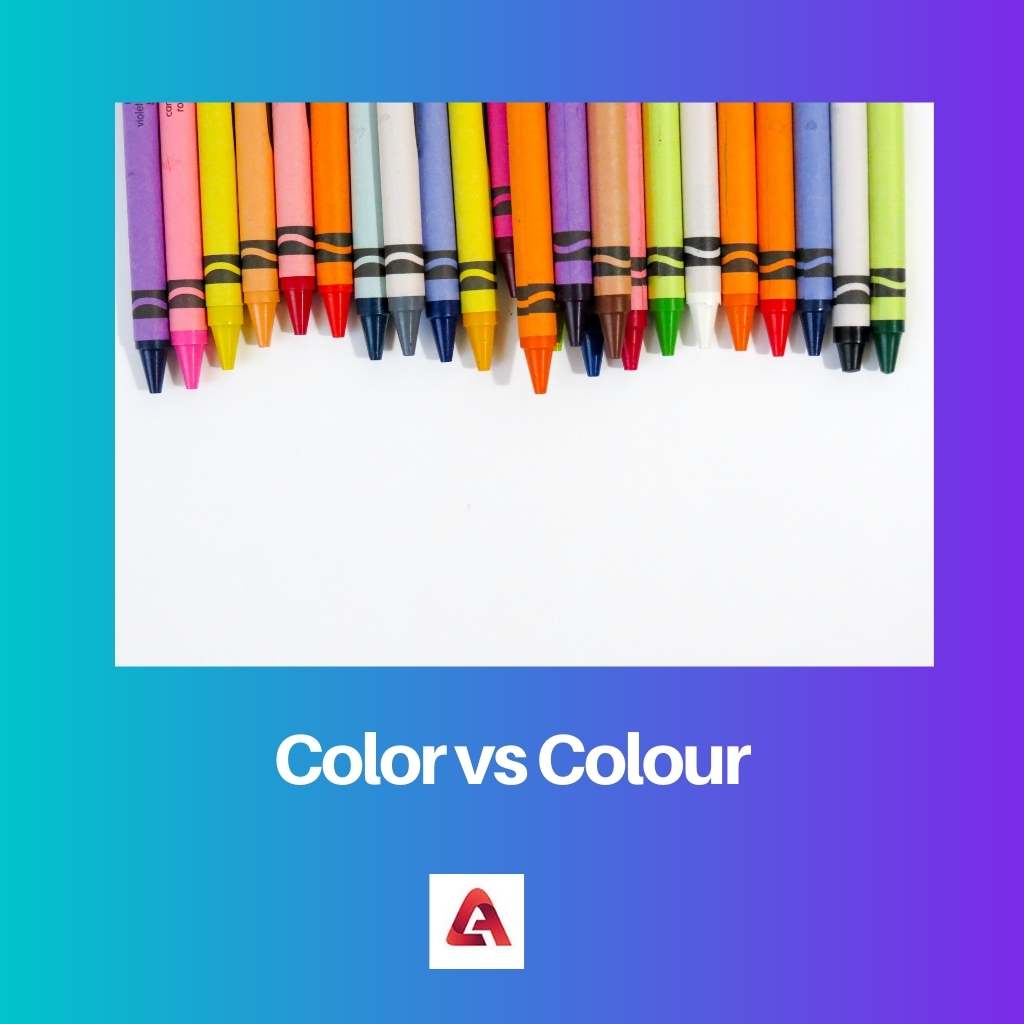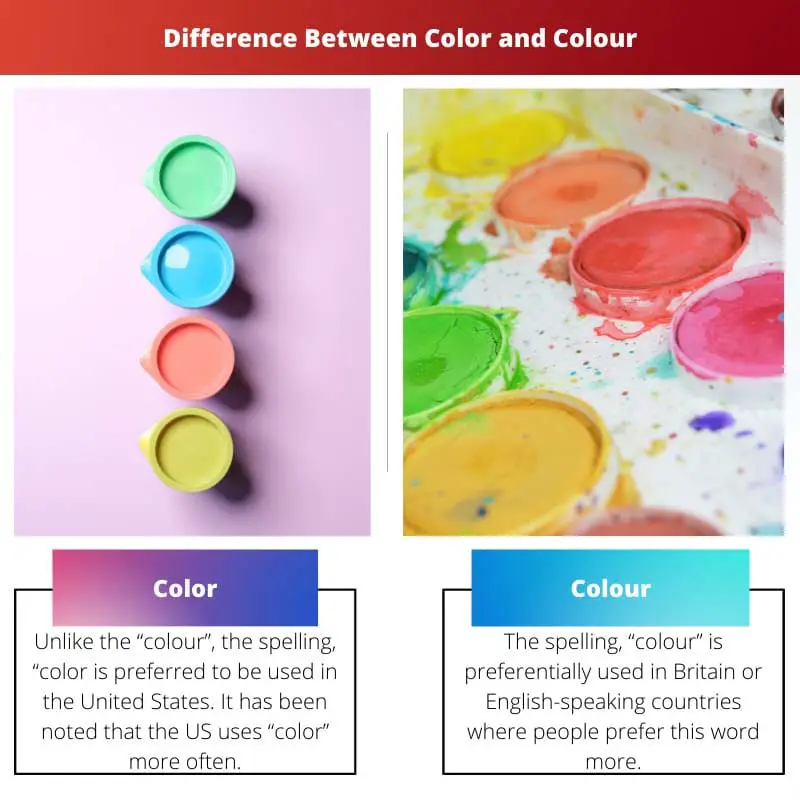“Color” and “Colour” differ in terms of preference in different regions of English language usage.
Though both the terms are the same and can be used in the same contexts, the United States prefers the word “color” over “color”. On the other hand, the United Kingdom prefers the usage of “colour” more.
Key Takeaways
- Color is the American spelling, while colour is the British spelling.
- The meaning of the two words is the same – they both refer to the property of an object that produces different sensations in the eye.
- The use of color vs colour depends on the English dialect.
Color vs Colour
The difference between Color and Colour is that the spelling “color” is used in the United States, whereas the spelling “colour” is used in Canada, Australia, British, and other places. Both are grammatically correct and have the same meaning. There is a difference in preference based on the type of audience it is written or spoken to.

Color is known to be the acquired appearance as a result of reflection associated with specific visible light frequencies and absorbing others. The science of colors is popularly known as chromatics.
The triggering of the cone cells in the retina results in differentiating spectral sensitivity and color perceptions.
Colour is acquired with the mode of interaction among the eye’s light receptors having different spectral sensitivities and light spectrum. The visual perceptions of blue, yellow, green, red, and others can be categorized under colour.
It depends on physical characteristics like reflection, light absorption, emission spectra, and others.
Comparison Table
| Parameters Of Comparison | Color | Colour |
|---|---|---|
| Preference | Unlike the “colour”, the spelling, “color is preferred to be used in the United States. It has been noted that the US uses “color” more often. | The spelling, “colour” is preferentially used in Britain or English-speaking countries where people prefer this word more. |
| Originality | The term has its originality rooted in the Latin word, “color”. By Anglo-Norman color, this term came into play in middle English. | The spelling, “colour” has been extensively used by people from the 1800s even after the rising usage of the word, “color”. |
| Note to remember | As color doesn’t constitute a “u” therefore it is eligible for America that does not have a “u” in its name. | As colour possesses a different spelling with “u”, it is eligible for the audience from the United Kingdom that has “u” in its name. |
| Dominance | Though the use of “color” in place of “colour” has been noted to gain grounds in English, it is recessive to the word, “colour”. | “colour” is dominant over “color” from approximately the 1800s even after the latter has elevated its use in the English language. |
| Spelling | Color is a short spelling of the word “colour” and is rising to have a ground in the English language and is also preferred by the US. | Colour is the long spelling and can be used in the same context as “color”. It is used in the UK. |
What is Color?
While using the word as a noun, color is the resultant characteristic appearance acquired with the help of reflection of particular frequencies of visible light besides absorbing others.
During reflection, when the frequencies of light are blue on a blue surface, the object shows the characteristic appearance of blue. While using the word as a verb, color is known for providing anything with a hue or shade.
It can be obtained with the help of pencils, paints, or by using digital software. However, writers face several doubts regarding the different spellings of color while writing for an international audience.
Writers abide by the usage of only one spelling in every place of the writing. Thus, it can be inferred that “color” is largely used when the writing is meant for the audience having American people.
The difference in spectral sensitivity results in a variety of color perceptions based on a variety of cone cells. The degree by which the cells get triggered, different perceptions of colors are obtained.
Color science or better known as Chromatics, is claimed to be the science of color. The visible spectrum of colors is violet, cyan, blue, green, yellow, orange, and red.

What is Colour?
Colour is defined as the property of visual perception that can be corresponded in human beings as red, green, yellow, blue, and others.
It results from the interaction of the spectrum of light with the eye having light receptors constituting spectral sensitivities.
The physical characteristics of colour and categories of colour depend on the physical properties of objects like emission spectra, light absorption, reflection, and others.
The colour of objects is determined by the colour of the light surpassing their surfaces, travelling at a speed of c through the vacuum without passing through a medium like a prism.
The colour perceived is based on the wave velocity, incident illumination spectrum, the surface’s reflectance features, and the viewing and illumination angles.
In British English, the word color is spelt as colour. It has the same meaning as the word color.
The word “colour” is valid in every other place where the word “color” is used. Colour is used by many countries of the commonwealth and is not used in the United States.
However, the spelling is used according to the preference of the audience.
If the audience consists of Americans, “color” is used in place of “colour”, and in the case of British, Canadian, or Australian audiences, the word “colour” is used in place of “color”.

Main Differences Between Color and Colour
- Though the use of “color” in place of “colour” has been noted to gain grounds in English, Colour is more dominant.
- Color is used by people from the united states. On the other hand, colour is used by people from the United Kingdom.
- Color is originally rooted in the Latin word, “color”. Colour has been used vastly since the 1800s despite the increasing usage of the word, “color”.
- As color doesn’t possess “u”, it indicates that it is preferred in America, where this letter is absent. On the other hand, “colour” has a “u”, which is related to the United Kingdom.
- Color is the short form of colour. However, colour is dominantly used over the spelling “color”.


The detailed comparison table really helps in understanding the differences between the two spellings, and the references are also quite helpful.
This is a very informative article. It helps to understand the spelling preferences based on the audience. It is quite intriguing to observe the difference.
The article does a great job in explaining the preference of spelling in the United States and the United Kingdom.
This is a very enjoying article, it is very interesting to learn more about the differences, depending on the region where English is spoken.
Yes, it can really make a difference depending on the audience. Great explanation about the physical characteristics of color and colour.
The spelling preference differences focus more on historical roots than grammar. An interesting piece.
I never paid attention to the difference between color and colour. I appreciate the detailed explanation provided here.